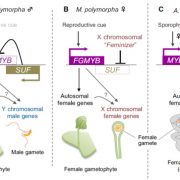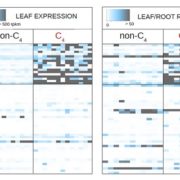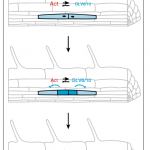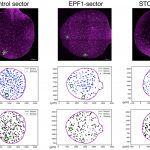Advanced vascular function discovered in a widespread moss (Nature Plants)
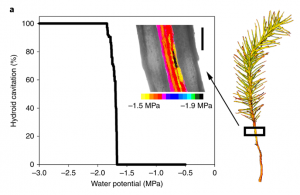 In order to grow upwards into the dry atmosphere, plants need to keep their elevated tissues hydrated and functional. In vascular plants this is achieved by a lignified water transport system in conjunction with stomatal regulation of gas exchange and the encasement of photosynthetic tissues in an impermeable cuticle. Bodribb et al. show that the widespread bryophyte Polytrichum commune possesses a vascular system that exhibits strong functional parallels with that of vascular plants. This includes water conducting cells (hydroids) that can conduct a continuous flow of water to elevated tissues, sufficient to maintain hydration and sustain steady-state photosynthesis. Hydroids are able to resist deformation even when exposed to water potentials within the operational range of angiosperm leaves, suggesting they may contain some-lignin like polymer which provides mechanical stiffness. The observed vulnerability to water-stress-induced cavitation of the vasculature of P. commune is again within the range of vascular plants, and P. commune is able to regulate transpiration to protect against cavitation. However, despite a functional vascular system and regulation of transpiration, P. commune is still not able to emerge far beyond the surface boundary layer and compete with vascular plants. The authors attribute this to the low intrinsic water use efficiency of P. commune, which renders photosynthesis highly sensitive to the regulation of transpiration that is required to avoid cavitation in a dry atmosphere. (Summary by Sophie Young @jeunesophie) Nature Plants 10.1038/s41477-020-0602-x
In order to grow upwards into the dry atmosphere, plants need to keep their elevated tissues hydrated and functional. In vascular plants this is achieved by a lignified water transport system in conjunction with stomatal regulation of gas exchange and the encasement of photosynthetic tissues in an impermeable cuticle. Bodribb et al. show that the widespread bryophyte Polytrichum commune possesses a vascular system that exhibits strong functional parallels with that of vascular plants. This includes water conducting cells (hydroids) that can conduct a continuous flow of water to elevated tissues, sufficient to maintain hydration and sustain steady-state photosynthesis. Hydroids are able to resist deformation even when exposed to water potentials within the operational range of angiosperm leaves, suggesting they may contain some-lignin like polymer which provides mechanical stiffness. The observed vulnerability to water-stress-induced cavitation of the vasculature of P. commune is again within the range of vascular plants, and P. commune is able to regulate transpiration to protect against cavitation. However, despite a functional vascular system and regulation of transpiration, P. commune is still not able to emerge far beyond the surface boundary layer and compete with vascular plants. The authors attribute this to the low intrinsic water use efficiency of P. commune, which renders photosynthesis highly sensitive to the regulation of transpiration that is required to avoid cavitation in a dry atmosphere. (Summary by Sophie Young @jeunesophie) Nature Plants 10.1038/s41477-020-0602-x



